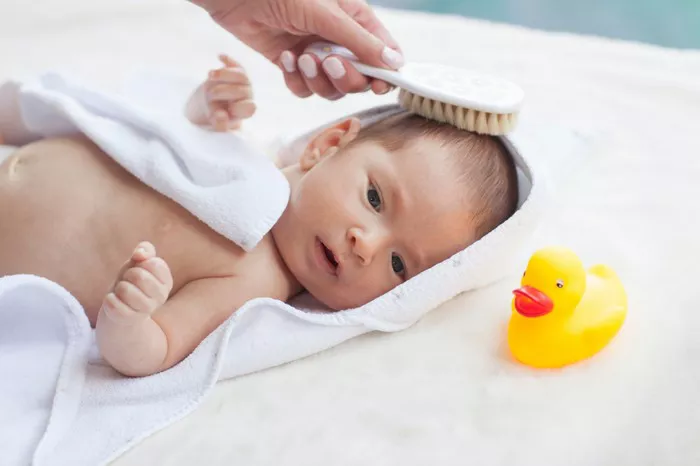Infant hair care is a delicate task that requires understanding the unique needs of your baby’s sensitive scalp and fine hair. Proper moisturizing is crucial to keep your baby’s hair healthy, soft, and manageable. This comprehensive guide will walk you through the best practices for moisturizing infant hair, ensuring your little one’s locks remain luscious and nourished.
Understanding Infant Hair
The Nature of Infant Hair
Infant hair is typically finer and more delicate than adult hair. It may be sparse, curly, straight, or even fall out completely before regrowing. The texture and density of an infant’s hair can vary widely, often changing as they grow.
The Importance of Moisturizing
Keeping your baby’s hair moisturized is essential for several reasons:
Prevents dryness and irritation: Dry hair can lead to scalp irritation and discomfort for your baby.
Reduces breakage: Proper hydration strengthens hair, reducing the likelihood of breakage.
Enhances natural curl patterns: For babies with curly hair, moisture helps define and maintain curls.
Choosing the Right Products
Gentle Shampoos and Conditioners
Selecting the right shampoo and conditioner is the first step in a healthy hair care routine. Look for products specifically designed for infants that are free from harsh chemicals, sulfates, and artificial fragrances.
Recommended Ingredients:
- Aloe Vera: Soothes and moisturizes the scalp.
- Chamomile: Gentle and calming for sensitive skin.
- Coconut Oil: Provides deep hydration and nourishment.
Leave-In Conditioners and Detanglers
Leave-in conditioners and detanglers can be beneficial, especially for curly or textured hair. These products help maintain moisture throughout the day and make combing easier.
Key Ingredients to Look For:
- Shea Butter: Rich in vitamins and fatty acids, it deeply nourishes hair.
- Jojoba Oil: Mimics natural scalp oils, providing balanced moisture.
- Argan Oil: Packed with antioxidants and vitamin E, it strengthens and hydrates hair.
Step-by-Step Moisturizing Routine
1. Gentle Cleansing
Frequency: Wash your baby’s hair once or twice a week to avoid stripping natural oils.
Steps:
1. Wet the hair: Use lukewarm water to wet your baby’s hair thoroughly.
2. Apply shampoo: Use a small amount of gentle baby shampoo, lathering it in your hands before applying.
3. Massage the scalp: Gently massage the scalp with your fingertips, avoiding vigorous scrubbing.
4. Rinse thoroughly: Ensure all shampoo is rinsed out to prevent residue build-up.
2. Conditioning
Frequency: Condition after every wash.
Steps:
1. Apply conditioner: Use a small amount of baby conditioner, focusing on the ends of the hair.
2. Comb through: Use a wide-tooth comb or your fingers to distribute the conditioner evenly.
3. Rinse: Rinse out the conditioner thoroughly with lukewarm water.
3. Leave-In Conditioning
Frequency: Apply after every wash and as needed between washes.
Steps:
1. Dab a small amount: Use a small amount of leave-in conditioner or detangler.
2. Distribute evenly: Apply to damp hair, focusing on the ends and avoiding the scalp.
3. Comb through: Use a wide-tooth comb to ensure even distribution.
4. Daily Moisturizing
Frequency: Moisturize daily or as needed.
Steps:
1. Choose a light oil or cream: Select a moisturizing product appropriate for your baby’s hair type.
2. Apply sparingly: Use a small amount to avoid weighing down the hair.
3. Focus on the ends: Apply primarily to the ends and any particularly dry areas.
5. Nighttime Protection
Frequency: Every night.
Steps:
1. Use a satin or silk bonnet: These materials help retain moisture and reduce friction.
2. Consider a satin pillowcase: If your baby is uncomfortable with a bonnet, a satin pillowcase can be an alternative.
Special Considerations for Curly and Textured Hair
Moisture Retention
Curly and textured hair types often require additional moisture. Products with heavier oils and butters can help maintain hydration.
Recommended Ingredients:
- Avocado Oil: Deeply moisturizing and rich in nutrients.
- Mango Butter: Provides long-lasting moisture and softness.
- Castor Oil: Thick and nourishing, ideal for sealing in moisture.
Protective Styles
Protective styles, such as braids or twists, can help reduce breakage and maintain moisture. Ensure styles are not too tight, which can cause tension and damage to the hair and scalp.
See Also: How to Do Rice Water Hair Treatment: A Beginner’s Guide
Avoiding Common Mistakes
Over-Washing
Frequent washing can strip natural oils from your baby’s hair, leading to dryness. Stick to washing once or twice a week unless your baby’s hair is particularly dirty.
Using Harsh Products
Avoid products containing sulfates, parabens, and artificial fragrances. These can irritate your baby’s scalp and dry out their hair.
Neglecting the Scalp
A healthy scalp is crucial for healthy hair growth. Ensure the scalp is clean and moisturized without overloading it with products.
Ignoring Signs of Sensitivity
If your baby shows signs of irritation or allergic reaction to a product, discontinue use immediately and consult a pediatrician if necessary.
DIY Moisturizing Treatments
Natural Oils
Natural oils can be used to moisturize your baby’s hair effectively.
Coconut Oil Treatment:
1. Warm a small amount: Melt coconut oil between your hands.
2. Apply to hair: Focus on the ends and any dry areas.
3. Comb through: Use a wide-tooth comb to distribute evenly.
4. Leave overnight: Rinse out the next morning for deeply hydrated hair.
Herbal Rinses
Herbal rinses can soothe the scalp and add shine to your baby’s hair.
Chamomile Rinse:
1. Brew a strong chamomile tea: Allow it to cool completely.
2. Apply after shampooing: Pour the rinse over your baby’s hair.
3. Do not rinse out: Let it air dry for added shine and softness.
Conclusion
Properly moisturizing your infant’s hair is essential for maintaining its health and softness. By selecting the right products, establishing a gentle hair care routine, and understanding the unique needs of your baby’s hair type, you can ensure your little one’s locks remain well-nourished and beautiful. Remember to be patient and gentle, as your baby’s hair care needs will evolve as they grow. With these tips and techniques, you’ll be well-equipped to keep your baby’s hair moisturized and healthy.


